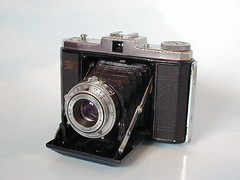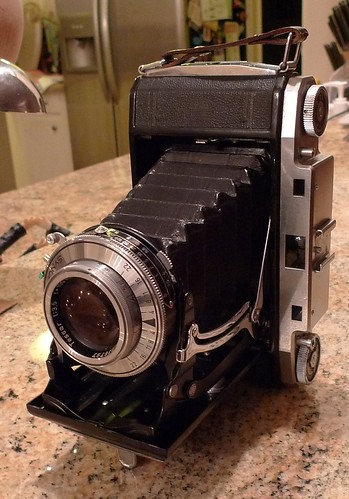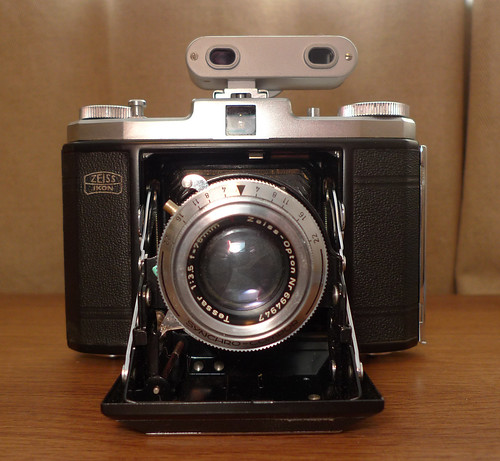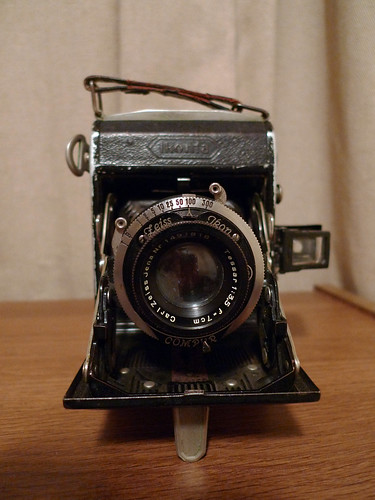I find something intriguing about medium format folding cameras. I think it is due to the combination of larger MF negatives, pocketability, simplicity, and relatively low cost. Medium format folding cameras were popular from the 1930s to the 1950s.
If someone doesn't own a medium format camera, they are cheap way to get into it. Compared to a Lomo camera, even the simplest folders have a triplet lens (versus single element plastic lenses), 3 more shutter speeds, and an adjustable aperature that is 2-3 stops faster at its widest.
What Drives Price
Camera collectors can radically change the price of seemingly similar cameras. However, there are distinct differences that can change the price from $10 to $400.
- Number of lens elements: Cameras with 4-element lenses such Zeiss Tessar, Voigtlander Skopar, or Agfa Solinar command substantial premiums. Most folders tend to have lenses that are in the style of a Cooke Triplet, such Agnar, Apotar, Voigtar, Vaskar, Novar, Nettar, or Radionar. They often have the word Anastigmat after the name. They are not bad lenses and offer similar performance at apertures f/8 and smaller. Voigtlander equipped some of its folders with 5 element Heliar lenses - very expensive
- Lens coating: Post-war lenses are coated which helps reduce flare and increase contrast. This is nice feature, but it doesn't mean uncoated lenses are dogs. To the collector, a coated 4 element lens command a significant premium.
- Shutter: Better shutter offer more shutter speeds and flash synchronization. The grand poobah of shutters is the Synchro-Compur with a top speed of 500 and a flash synchronization. Earlier Compur and Compur Rapid shutter are quality shutters. Prontor made a line of quality shutter that are just behind the Compur is quality, but still highly useable. Vario shutters were some of the simpler shutters with three shutter speed plus bulb. Tempor shutters are East German versions of the Compur. I have difficulty trusting the quality of the Eastern Bloc camera equipment.
- Rangefinder: Rangefinders help focus the camera. Without one, you have to guess the distance to your subject. Rangefinders that can be coupled or uncoupled. With an uncoupled rangefinder, you use the rangefinder to determine the distance, then manually set the distance on the focussing ring. There are few folders with coupled rangefinders and these command the highest prices. Models with uncoupled rangefinders also command premiums.
- Condition: Besides cosmetic condition, old cameras can get problems: Slow speeds on the shutters can stick, lenses can get cloudy or get fungus. One of the prime areas where folders can get problems is their bellows. Almost every Agfa or Ansco model needs new bellows because the material they used was subpar. They develop pinhole leaks, so you can see by plain visual inspection. I shine a high powered flashlight into the back of the camera.
- Format: Folders that use 120 film shoot one of three formats: 6x4.5, 6x6, 6x9. Price doesn't vary greatly between models, but 6x6 format is the most common, so the most bargain finds will be here.
- Oddities: Collectors go for various ancillary things that have no bearing on how a camera performs, such as the original box, or a MIOJ stamp (Made in Occupied Japan),.
If I had to recommend one for someone looking for a folder without wanting to commit much money, it would be one of the post-war Zeiss Nettar. Zeiss has the best reputation for build quality and their bellows are typically still light tight.. They typically go for $20-$25. Zeiss had a million different models, so a picture is worth 1,000 words:
Manufacturers:
- Zeiss made a full line of Nettar and Ikonta models starting in the early 1930s.
- Agfa made a range of Isolette cameras. Ansco had a JV with Agfa and had nearly identical cameras branded Speedex.
- Welta is less known but made good cameras. The Perle is 645 and the Weltax is a 6x6. The Weltur came in 6x9 or 6x6 versions. The big advantage is that it is unit focusing, means that the whole lens moves to focus, not just the front element which is common to most folders.
- Voigtlander was another major manufacturer. Perkeo was the 6x6 and the Bessa is a 6x9. There was also a Bessa 6x6.
- Certa, Balda, Ensign, Franka, and Dacora were other European companies that made reasonably quality folding cameras
- Kodak made a lot of folding cameras, but Kodak has a reputation for making junky cameras, withstanding their Retina line (which was made by Nagel). A lot of Kodak folding cameras also use film that is no longer available, such as 620 or 116.
Zeiss Ikonta 524/2: It's a 6x9 from the early-mid 1950s, with a Synchro-Compur shutter and a coated 105/3.5 Tessar lens, and an uncoupled rangefinder. I upgrade to this from the very capable Ikonta 523/2 (added the uncoupled rangefinder).
Zeiss Ikonta 523/16 with a Synchro-Compur shutter and a 75/3.5 Tessar lens.
Ansco Speedex B2. This is a 6x6 from about 1940, with an uncoated Agfa (triplet) 85/4.5 lens with an unnamed shutter, but it has 7 speeds, similar to a Compur.
Zeiss Ikonta 520 A. It is a 6x4.5 camera from 1933 or 1934. It has an uncoated 70/3.5 Tessar with a Compur shutter
Links
Price List - Post 1950, Zeiss Ikon 120 Folders
Zeiss Ikonta 523/2 Reviewed
Zeiss Ikonta 524/2 Reviewed
Agfa Ansco B2 Speedex Reviewed





No comments:
Post a Comment